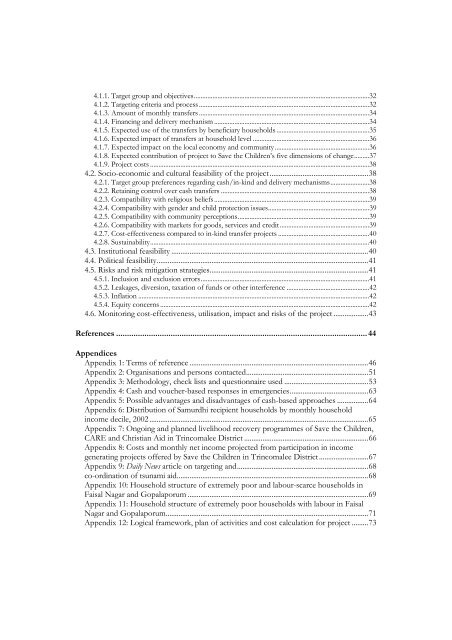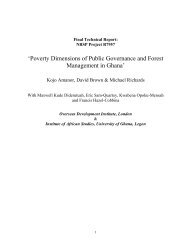Feasibility study on a capital-based income generation scheme for ...
Feasibility study on a capital-based income generation scheme for ...
Feasibility study on a capital-based income generation scheme for ...
You also want an ePaper? Increase the reach of your titles
YUMPU automatically turns print PDFs into web optimized ePapers that Google loves.
4.1.1. Target group and objectives........................................................................................................32<br />
4.1.2. Targeting criteria and process.....................................................................................................32<br />
4.1.3. Amount of m<strong>on</strong>thly transfers .....................................................................................................34<br />
4.1.4. Financing and delivery mechanism ............................................................................................34<br />
4.1.5. Expected use of the transfers by beneficiary households .......................................................35<br />
4.1.6. Expected impact of transfers at household level .....................................................................36<br />
4.1.7. Expected impact <strong>on</strong> the local ec<strong>on</strong>omy and community........................................................36<br />
4.1.8. Expected c<strong>on</strong>tributi<strong>on</strong> of project to Save the Children’s five dimensi<strong>on</strong>s of change.........37<br />
4.1.9. Project costs ..................................................................................................................................38<br />
4.2. Socio-ec<strong>on</strong>omic and cultural feasibility of the project......................................................38<br />
4.2.1. Target group preferences regarding cash/in-kind and delivery mechanisms.......................38<br />
4.2.2. Retaining c<strong>on</strong>trol over cash transfers ........................................................................................38<br />
4.2.3. Compatibility with religious beliefs............................................................................................39<br />
4.2.4. Compatibility with gender and child protecti<strong>on</strong> issues............................................................39<br />
4.2.5. Compatibility with community percepti<strong>on</strong>s..............................................................................39<br />
4.2.6. Compatibility with markets <strong>for</strong> goods, services and credit.....................................................39<br />
4.2.7. Cost-effectiveness compared to in-kind transfer projects ......................................................40<br />
4.2.8. Sustainability..................................................................................................................................40<br />
4.3. Instituti<strong>on</strong>al feasibility ............................................................................................................40<br />
4.4. Political feasibility....................................................................................................................41<br />
4.5. Risks and risk mitigati<strong>on</strong> strategies.......................................................................................41<br />
4.5.1. Inclusi<strong>on</strong> and exclusi<strong>on</strong> errors....................................................................................................41<br />
4.5.2. Leakages, diversi<strong>on</strong>, taxati<strong>on</strong> of funds or other interference .................................................42<br />
4.5.3. Inflati<strong>on</strong> .........................................................................................................................................42<br />
4.5.4. Equity c<strong>on</strong>cerns ............................................................................................................................42<br />
4.6. M<strong>on</strong>itoring cost-effectiveness, utilisati<strong>on</strong>, impact and risks of the project ...................43<br />
References ................................................................................................................... 44<br />
Appendices<br />
Appendix 1: Terms of reference ..................................................................................................46<br />
Appendix 2: Organisati<strong>on</strong>s and pers<strong>on</strong>s c<strong>on</strong>tacted...................................................................51<br />
Appendix 3: Methodology, check lists and questi<strong>on</strong>naire used ..............................................53<br />
Appendix 4: Cash and voucher-<strong>based</strong> resp<strong>on</strong>ses in emergencies...........................................63<br />
Appendix 5: Possible advantages and disadvantages of cash-<strong>based</strong> approaches .................64<br />
Appendix 6: Distributi<strong>on</strong> of Samurdhi recipient households by m<strong>on</strong>thly household<br />
<strong>income</strong> decile, 2002........................................................................................................................65<br />
Appendix 7: Ongoing and planned livelihood recovery programmes of Save the Children,<br />
CARE and Christian Aid in Trincomalee District ....................................................................66<br />
Appendix 8: Costs and m<strong>on</strong>thly net <strong>income</strong> projected from participati<strong>on</strong> in <strong>income</strong><br />
generating projects offered by Save the Children in Trincomalee District...........................67<br />
Appendix 9: Daily News article <strong>on</strong> targeting and........................................................................68<br />
co-ordinati<strong>on</strong> of tsunami aid.........................................................................................................68<br />
Appendix 10: Household structure of extremely poor and labour-scarce households in<br />
Faisal Nagar and Gopalaporum ...................................................................................................69<br />
Appendix 11: Household structure of extremely poor households with labour in Faisal<br />
Nagar and Gopalaporum...............................................................................................................71<br />
Appendix 12: Logical framework, plan of activities and cost calculati<strong>on</strong> <strong>for</strong> project .........73
















